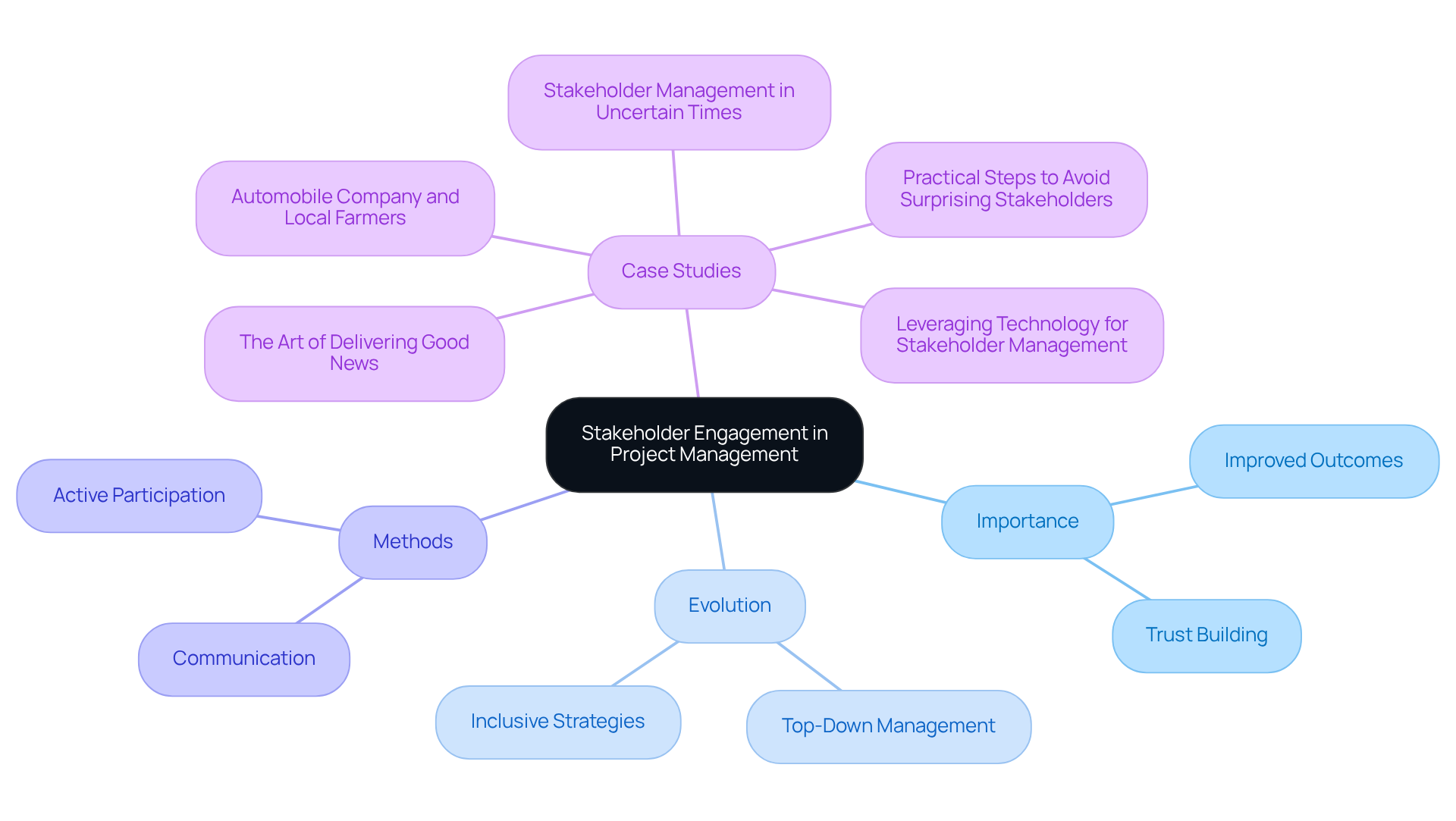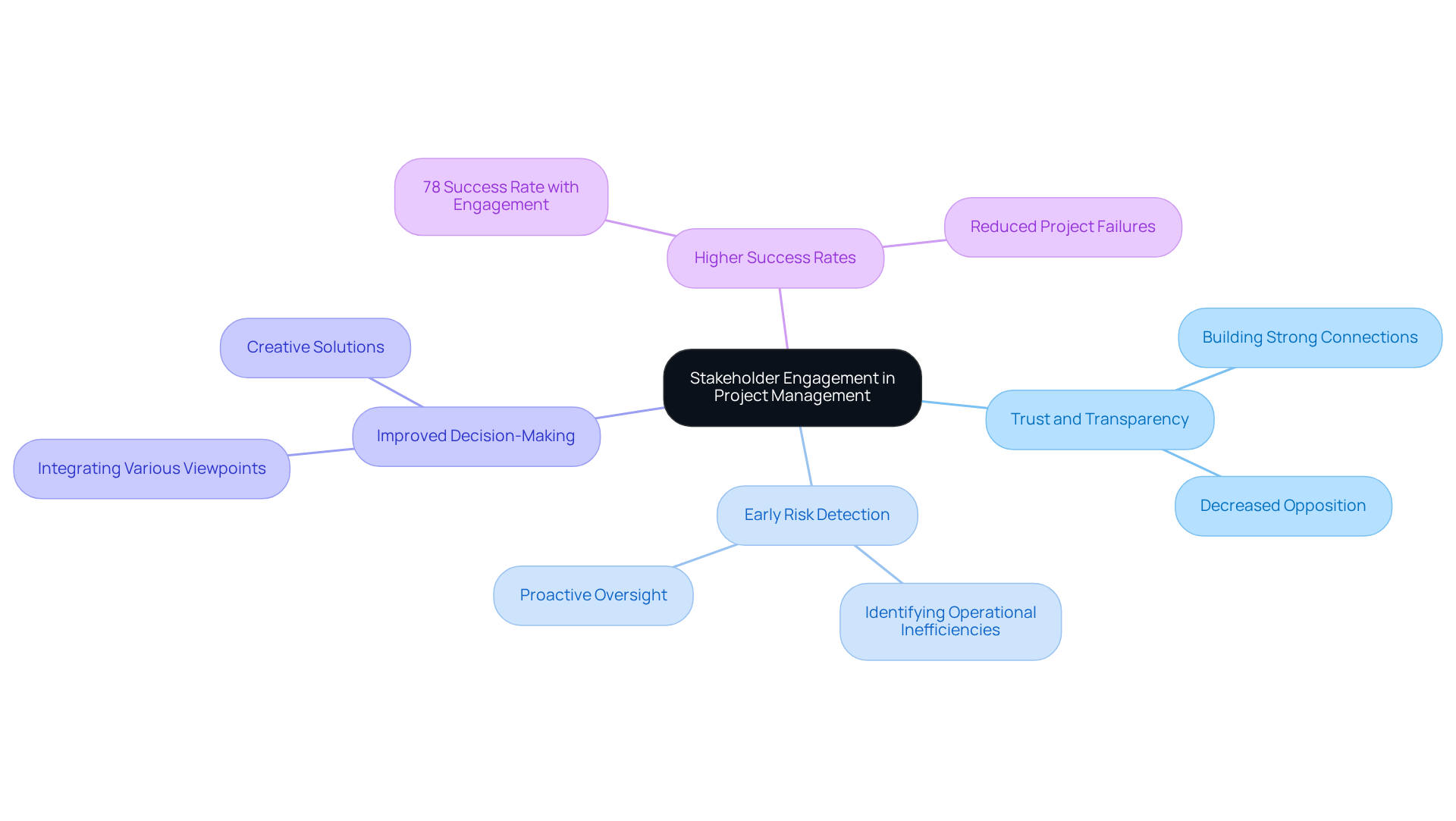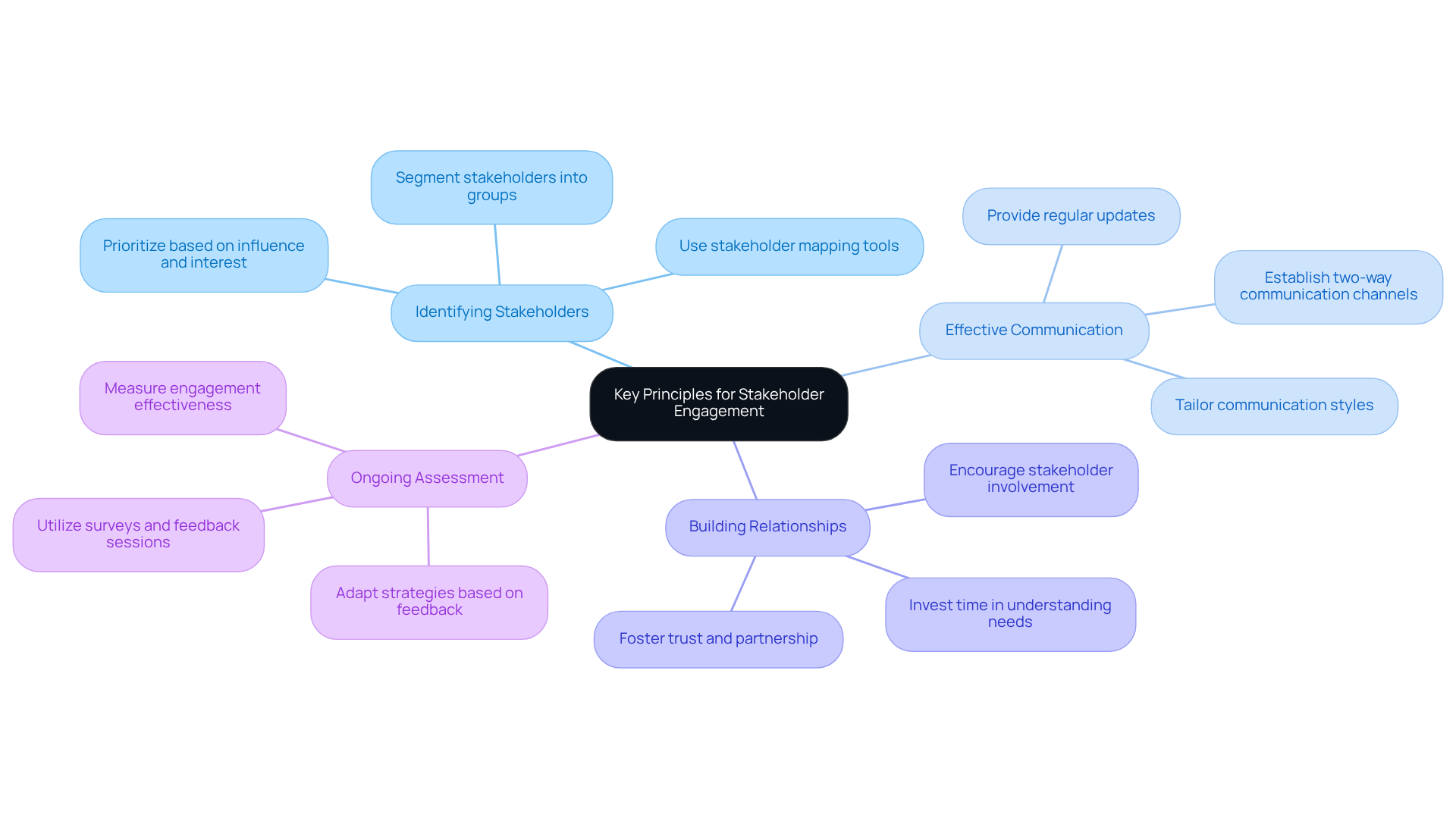Overview
Stakeholder engagement in project management is a critical process involving the systematic identification, analysis, and management of individuals or groups impacted by a project. This engagement ensures their active participation in decision-making processes. Effective engagement not only fosters trust but also enhances decision-making capabilities, ultimately leading to significantly increased project success rates.
Data reveals that initiatives characterized by high stakeholder involvement achieve an impressive success rate of 78%. Recognizing the importance of this engagement is essential for any project manager aiming for success.
Introduction
In the realm of project management, the ability to effectively engage stakeholders has emerged as a critical component that can make or break an initiative. By actively involving individuals and groups who are impacted by a project, organizations can foster collaboration, enhance decision-making, and ultimately drive success.
However, as the landscape of stakeholder engagement evolves, questions arise:
- What strategies are most effective in ensuring that all voices are heard?
- How can project managers navigate the complexities of diverse stakeholder needs while maintaining project momentum?
Exploring these themes reveals the profound impact of stakeholder engagement on project outcomes and the best practices that can lead to sustainable success.
Defining Stakeholder Engagement in Project Management
In project management, stakeholder engagement is pivotal for the systematic identification, analysis, and management of individuals or groups impacted by an endeavor. This includes a diverse range of participants, from sponsors and team members to customers and regulatory bodies. To comprehend stakeholder engagement in project management, effective engagement with these stakeholders necessitates not only communication but also their active participation in the decision-making process. This collaborative approach ensures that the needs and expectations of all involved parties are acknowledged and addressed, ultimately leading to improved outcomes.
The concept of stakeholder involvement has evolved significantly, illustrating a shift from traditional top-down management methods to more inclusive and participatory strategies. As we approach 2025, the significance of engaging interested parties is underscored by the fact that 82% of organizations implement strategies aimed at enhancing decision-making and results. Furthermore, the rise of virtual tools such as content voting and surveys is becoming increasingly crucial, as they promote greater participation among digitally adept demographics.
A compelling case study highlights the consequences of inadequate stakeholder involvement: an automobile company faced substantial resistance from local farmers when attempting to establish a manufacturing facility in India, ultimately leading to the project's abandonment. This scenario underscores the urgent need for effective involvement strategies. As these strategies continue to evolve, there is a growing emphasis on inclusivity, essential for navigating the complexities of modern initiatives. Open communication remains a cornerstone of successful stakeholder engagement in project management, which is essential for fostering trust and collaboration among all parties involved.

The Importance of Stakeholder Engagement for Project Success
Understanding what is stakeholder engagement in project management is crucial for success for several compelling reasons. It promotes trust and transparency, essential for building strong connections with interested parties. When stakeholders feel appreciated and listened to, their backing for the initiative grows, resulting in decreased opposition and improved teamwork.
Moreover, efficient involvement allows for the early detection of possible risks and concerns throughout the lifecycle, promoting proactive oversight and mitigation tactics. For example, in a restructuring initiative, engaging employees can reveal operational inefficiencies that may not be apparent to management.
Furthermore, the involvement of interested parties improves decision-making by integrating various viewpoints, leading to more creative solutions and better results. Organizations that emphasize the participation of interested parties often observe considerably higher success rates for their initiatives, with data showing that endeavors with highly involved contributors attain a success rate of 78%.
Understanding what is stakeholder engagement in project management is crucial, as this emphasis on involvement enhances participant satisfaction and fortifies the overall project structure, making it an essential element of effective project management.

Key Principles and Strategies for Effective Stakeholder Engagement
Successful involvement of interested parties hinges on several key principles. First, it is crucial to identify and prioritize involved parties based on their influence and interest. This strategic approach enables project managers to customize their engagement tactics effectively. Research indicates that companies interacting with interested parties are 50% more likely to achieve their significant objectives, underscoring the importance of this step.
Moreover, communication must be clear, consistent, and interactive. Establishing two-way communication channels ensures that interested parties are not only informed but also have opportunities to provide feedback. Regular updates and open forums for discussion can significantly enhance this interaction, fostering a collaborative environment.
In addition, building strong relationships is essential. Project managers should invest time in understanding the needs and concerns of interested parties, which cultivates a sense of partnership and trust. Engaged parties are more likely to offer resources and assistance, recognizing the project's advantages and committing to its success.
Lastly, ongoing measurement and assessment of involvement efforts are vital. Adapting strategies based on feedback and performance metrics can lead to improved effectiveness. Methods such as mapping participants—classifying them according to their influence and interest—along with surveys and feedback sessions, provide valuable insights into perceptions and involvement levels. For instance, groups that adopt strategies for engaging interested parties frequently observe a notable increase in success rates, with 78% of initiatives involving these parties reaching their goals.
By adhering to these principles, project managers can establish a robust framework that defines what is stakeholder engagement in project management, ultimately enhancing project outcomes and fostering sustainable growth.

Conclusion
Stakeholder engagement in project management stands as a fundamental practice that centers on the systematic identification and involvement of all parties affected by a project. This approach not only fosters communication but also ensures active participation in decision-making, which is essential for recognizing and addressing the diverse needs and expectations of stakeholders. As the landscape of project management evolves, the emphasis on inclusive and participatory strategies becomes increasingly vital for achieving successful project outcomes.
The article underscores several key arguments that reinforce the importance of stakeholder engagement:
- Effective engagement builds trust and transparency.
- It enhances decision-making by incorporating varied perspectives.
- It facilitates early detection of potential risks.
Statistics reveal that organizations prioritizing stakeholder involvement experience significantly higher success rates, with engaged contributors driving project success. Furthermore, the principles of prioritizing stakeholders, maintaining clear communication, and fostering strong relationships are crucial for effective engagement strategies.
Ultimately, embracing stakeholder engagement transcends mere procedural compliance; it cultivates a collaborative environment that enriches project initiatives. By acknowledging the critical role of stakeholders and implementing best practices, project managers can ensure not only the success of their projects but also the satisfaction of all involved parties. Taking proactive steps to engage stakeholders will yield lasting benefits, paving the way for future growth and improved project outcomes.
Frequently Asked Questions
What is stakeholder engagement in project management?
Stakeholder engagement in project management refers to the systematic identification, analysis, and management of individuals or groups impacted by a project, which includes sponsors, team members, customers, and regulatory bodies.
Why is stakeholder engagement important?
Effective stakeholder engagement is crucial as it ensures that the needs and expectations of all involved parties are acknowledged and addressed, leading to improved project outcomes.
How has the concept of stakeholder involvement evolved?
The concept has shifted from traditional top-down management methods to more inclusive and participatory strategies, emphasizing collaboration and active participation in decision-making processes.
What percentage of organizations implement strategies to enhance stakeholder engagement?
As we approach 2025, 82% of organizations are implementing strategies aimed at enhancing decision-making and results through stakeholder engagement.
What role do virtual tools play in stakeholder engagement?
Virtual tools such as content voting and surveys are becoming increasingly important as they promote greater participation among digitally adept demographics.
Can you provide an example of the consequences of inadequate stakeholder involvement?
An automobile company faced significant resistance from local farmers when trying to establish a manufacturing facility in India, which ultimately led to the project's abandonment, highlighting the need for effective involvement strategies.
What is emphasized in modern stakeholder engagement strategies?
Modern strategies emphasize inclusivity and open communication, which are essential for navigating the complexities of contemporary projects and fostering trust and collaboration among all parties involved.




